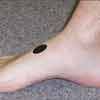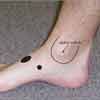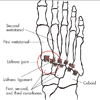Musculoskeletal Clinics: Foot Pain After Skateboarding Accident
A 17-year-old boy with no history of foot problems decided to try some new moves with his skateboard on a steep ramp. Midway down the ramp, he tumbled head over heels and landed with most of his weight on his plantar-flexed right foot.

PATIENT PROFILE:
A 17-year-old boy with no history of foot problems decided to try some new moves with his skateboard on a steep ramp. Midway down the ramp, he tumbled head over heels and landed with most of his weight on his plantar-flexed right foot. He does not think he twisted his ankle. He felt fine until he tried to stand up. At this point he felt pain on the top of his right foot and could not bear weight on that foot.
Friends took him to the local emergency department. Standard radiographs revealed no fracture. The foot was immobilized with a soft cast, and he was advised to use crutches. The next day he noticed increasing pain and swelling in the injured foot.
Three days later, the patient sees his primary care physician because the pain and swelling have continued to worsen. Examination of the left foot reveals no abnormalities. Examination of the right foot (after cast removal) reveals significant swelling from the dorsum of the midfoot to the toes, with significant ecchymosis over the same area. Marked tenderness is noted over the second and first tarsometatarsal joints in the midfoot (Figure 1). Palpation reveals no tenderness on the plantar surface, lateral or medial malleolus, or fifth metatarsal head.
Pedal pulses are present, and the patient is able to dorsiflex his foot fully to 30 degrees against resistance (similar to the left foot). Active inversion and eversion of the ankle--both unresisted and against resistance--are uncomfortable but accomplished with ease. Plantar flexion is limited and painful, and the patient is unable to bear weight on his right foot without significant pain. No neurologic deficits are noted.
WHAT WOULD YOU DO NOW?
WHAT IS YOUR PRESUMPTIVE DIAGNOSISAT THIS POINT?
A. Fifth metatarsal fracture.
B. Anterior talofibular ligament tear.
C. Posterior tibial tendon rupture.
D. Navicular fracture.
E. None of the above.
THE CONSULTANT'S CHOICE
None of the 4 injuries proposed is a likely diagnosis. Lack of tenderness over the head of the fifth metatarsal on palpation makes a fifth metatarsal fracture (A) unlikely.1 An anterior talofibular ligament tear (lateral ankle sprain) (B) is usually associated with tenderness over the anterior portion of the lateral malleolus and a decreased ability to dorsiflex the foot.2 Moreover, both fifth metatarsal fractures and anterior talofibular ligament tears usually occur with inversion; this does not seem to have been the mechanism of injury in this case.
Rupture of the posterior tibial tendon (C) usually occurs with chronic tibial tendonitis rather than secondary to trauma; also, inversion of the ankle is not possible if the tendon is ruptured. This patient has no history of chronic foot problems and is able to invert his foot; thus, posterior tibial tendon rupture is not likely.
Acute navicular fractures (D) occur when eversion stress causes a bony avulsion of the medial deltoid ligaments from the navicular bone. Tenderness is located closer to the medial malleolus, over the navicular area--not over the dorsum as it is in this patient (Figure 2). Moreover, navicular fractures are usually evident on radiographs. This patient's films revealed no fractures.

WHICH OPTION IS MOST APPROPRIATE AT THIS POINT?
A.
Continue to treat the patient with crutches and avoidance of weight bearing for another2 weeks.
B.
Have him start a rehabilitation program with a physical therapist.
C.
Obtain non-weight-bearing radiographs of the right foot.
D.
Obtain weight-bearing radiographs of the right foot.
THE CONSULTANT'S CHOICE
The lack of a diagnosis makes both continued conservative treatment (A) and starting rehabilitation (B) inappropriate. The patient may have a problem that is made worse by delaying specific treatment. Additional imaging studies are indicated to help with diagnosis.
A CT scan (E) is expensive and is best considered only if the less expensive plain films prove unhelpful. Because of this patient's initial statement that he first experienced pain with weight bearing and his continued difficulty with weight bearing, ordering weight-bearing films (D) is most appropriate at this time.
Anteroposterior (AP), lateral, and oblique weight-bearing radiographs are obtained; they reveal a 3- to 4-mm diastasis between the base of the first and second metatarsals. This is evidence of a Lisfranc joint injury.
Anatomy of the Lisfranc joint. The Lisfranc joint is composed of the medial articulation of the first and second metatarsals with the medial (first) and middle (second) cuneiforms (Figure 3).

The joint is named after a French field surgeon, Jacques Lisfranc, who described an amputation performed through this joint because of gangrene that had developed after a soldier fell off his horse and caught his foot in a stirrup.
The Lisfranc joint is susceptible to separation and dislocation dorsally because no intermetatarsal ligament runs between the bases of the first and second metatarsal (see Figure 3). There are strong intermetatarsal ligaments between the bases of the second through fifth metatarsals that provide a significant amount of dorsal stability (see Figure 3). A strong ligament (called the Lisfranc ligament) runs between the medial cuneiform and the base of the second metatarsal. This ligament, which runs in a plantar direction, stabilizes the second metatarsal in its mortise. However, the joint capsule and dorsal ligaments provide minimal--and the only--support on the dorsal surface of the Lisfranc joint. The bony architecture of this joint is the focal point that supports the entire tarsometatarsal articulation. Its anatomy constitutes a "weak link" that with stress is prone to injury.3,4
Mechanisms of injury. Lisfranc joint injury can occur as the result of a direct external force striking the foot or as the result of an indirect force being transmitted to a stationary foot. The indirect force can be the weight of the body, which produces a compression or rotary force. With the foot in extreme plantar flexion, a significant axial load in a downward direction displaces the second metatarsal at its base. This situation occurs in falls, in which the axial load may be 2 to 3 times body weight (depending on the height of the fall) and in automobile and motorcycle accidents, in which the velocity at the moment of impact may be great.
The most common type of Lisfranc injury (type 1) is a sprain that results from a simple fall or a sports- related injury. Type 1 injuries are associated with pain and swelling but no instability or diastasis. Higher height or velocity injuries (types 2 and 3) produce more pain, swelling, and disability and are associated with diastasis (as seen in this patient) and fracture dislocations.
Diagnosis. Lisfranc joint injuries are rare and often misdiagnosed. Early diagnosis and proper treatment improve the chance of successful healing and reduce the likelihood of post-injury arthritis and difficulty in walking.
If you suspect Lisfranc joint injury, order radiographs that include weight-bearing AP, lateral, and oblique views of both feet so that you can compare the 2 sides. In a normal foot, a weight-bearing AP view shows the lateral margin of the first metatarsal base lined up with the lateral edge of the medial (first) cuneiform, and the medial margin of the second metatarsal base lined up with the medial edge of the middle (second) cuneiform; both the AP and oblique weight-bearing views in a normal foot show the medial border of the fourth metatarsal lined up with the medial border of the cuboid. If there is misalignment of these edges, suspect a Lisfranc joint injury. With significant misalignment between the metatarsals, a separation or diastasis may be evident, as in this case.
Look for the presence of small avulsed fragments ("fleck sign"), which are indications of ligamentous injury and probable joint disruption. Dislocation may be demonstrated on the lateral view by a "step off" of the second metatarsal. This indicates that the dorsal surface of the proximal second metatarsal is higher than the dorsal surface of the middle (second) cuneiform and is diagnostic of Lisfranc injury.
WHAT WOULD YOU DO NEXT?
A. Obtain a CT scan of the injured foot.
B. Refer the patient to an orthopedic surgeon.
C. Place a non-weight-bearing cast on the footfor 6 week
D. Refer the patient to a physical therapist forrehabilitation.
THE CONSULTANT'S CHOICE
Type 1 Lisfranc injuries can be treated with avoidance of weight bearing for 4 to 6 weeks, but type 2 and type 3 injuries require surgery. Treatment with a non-weight-bearing cast (C) would be acceptable if no diastasis were present on the radiograph. Because diastasis is present between the base of the first and second metatarsals, this patient has a type 2 injury and thus requires surgery (B).
A CT scan (A) may be helpful in diagnosing difficult cases of Lisfranc joint injury and in formulating a surgical treatment plan. However, the weight-bearing films provide sufficient information for those decisions a primary care physician is called on to make. The orthopedic surgeon will decide whether a CT scan will help with his management decisions. Although rehabilitation (D) is not indicated at this time, it will be of value postoperatively.
Complications of Lisfranc injury. Compartment syndrome and disruption of the dorsalis pedis artery are 2 complications to watch for in patients with Lisfranc joint injuries. Excessive swelling can lead to compartment syndrome. The dorsalis pedis artery is located near the Lisfranc joint, and joint disruption may compromise the artery. A bounding dorsalis pedis pulse and lack of neurologic deficit rule out both complications.5
Outcome of this case. The patient was treated surgically with open reduction and internal screw fixation and is now doing well.
References:
REFERENCES:
1.
Shahady EJ, Paull W, Brotherton S. Foot pain that causes a runner to limp.
Consultant.
2005;45:907-910.
2.
Shahady EJ, Paull W, Hemrajani R. Acute ankle pain in a runner.
Consultant.
2004;44:1529-1533.
3.
Burroughs KE, Reimer CD, Fields KB. Lisfranc injury of the foot: a commonly missed diagnosis.
Am Fam Physician.
1998;58:118-124.
4.
Mullen JE, O'Malley MJ. Sprains--residual instability of subtalar, Lisfranc joints, and turf toe.
Clin Sports Med.
2004;23:97-121.
5.
Shahady EJ, Paull W, Bass D. Lower leg pain in a runner.
Consultant.
2004;44: 1357-1360.
Low vitamin D levels associated with slowed fracture healing
September 29th 2024“Getting outside and enjoying the fresh air can do wonders for your health while also upping Vitamin D absorption, said Jessica McQuerry, MD, lead study author of an abstract presented at the 2024 AAP National Conference & Exhibition.